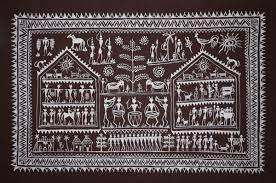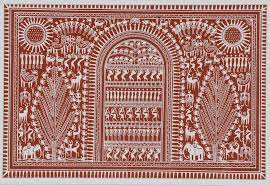by Ruchie Das|Published July 25, 2020-Updated July 25, 2020
Saura art is a tribal artform that has its origins in the religious practices of the Saura tribe of Odisha. Traditional saura art is painted painly on mud walls using natural colours and consists of stick figures similar but distinct from Worli art of Maharashtra.
Who are Sauras?
The Sauras are one of the oldest known tribes of India. They are widely distributed from Bundelkhand in the west to Odisha in the east. But they are found in great compactness on the edges of the Eastern ghats in Ganjam, Gajapati and Koraput District of Odisha and Srikakulam district of Andhra Pradesh.
The term Soura appears to have two connotations – one derived from Sagoriss, the Scythian word for axe and the other from Saba roye’, the Sanskrit term for carrying a dead boy. Both of them fit well with their habit of carrying an axe always on their shoulders with their primitive occupation of hunting.
The epics and puranas refer to their devotion to the Hindu religious heroes like Rama and the Jagannath cult.
Like other tribal communities, the Sauras are the indigenous, autochthons of India in the sense that they had been long settled in different parts of the country particularly on the plains and river valleys and other fertile areas. Many of the Sauras were in a food gathering economy and a few were perhaps on the threshold of a real food producing economy. On the whole, they are primitive, wild and poor.

Saura Art
The Sauras are probably one of the most primitive tribes of Orissa, but also one of the most dynamic and colourful. Like many tribal cultures all over the world, the art of the Sauras draws inspiration from their belief that the world is populated by a great company of Gods, as well as spirits of nature and their ancestors. It is a means of worship and invocation.
With simple forms and figures that come together to compose intricate narratives in very few colours, the captivating art of the Sauras, has told the story of the tribe for hundreds of years.
Saura art started out with its ritualistic beginnings on the walls of village homes by someone or the village shaman who is possessed by spirits and paints under the diktats of the spirits, to become one of the most beautiful artforms that India is proud of.
Language of the Tribe
With a history that has been mentioned in the Ramayana and the Mahabharata, the Sauras are known for their distinct tribal culture and their art. A tribe that is deeply attached to nature, their art on the surface seems to be a jejun depiction of everyday village life.
But the art of the Sauras is rich with symbolism and meaning, and it is through these images and their interpretation that the Saura people hold on to their customs and culture. For the Sauras, their language is art instead of having a script, & they use their art as a record of their history, their philosophy and religious practices.
You can read our another post on The Leaning Temple of Huma: A Unique Architectural Wonder

Methods and Symbolism
Saura art is customarily drawn on the red or brown clay walls of the homes of the villagers, using natural dyes made from rice, white stone, flower and leaf extracts, with a brush that is fabricated from tender bamboo.
Their paintings bear religious sentiments and values, their themes mostly revolve around their deity named Idital, and the Sauras offer these paintings to their deities as a token of gratitude. They are very closely linked to nature, they offer their prayers regularly for assistance and spiritual growth. These paintings use a fish-net model. The border is made followed with motifs closing inwards.
They incorporate the use of geometry creating triangles, there are other specific patterns used as a design in their works, and the pigments they have used were extracted from nature.
The figures in Saura artworks are called icons or ikons and many of them are recurring motifs and symbols, such as people, the tree of life, the sun and moon, horses, and elephants, which all hold their own symbolism.
Traditionally, it was only priests who could make these wall-paintings. They explain their meanings to the people, passing the tribal customs and culture in a distinctive oral tradition.
Other themes include the birth of a newborn baby, a satisfying harvest session and marriages that mark a special phase in an individual’s life. The sketches and scribbles are done on the wall; the routine life is heavily depicted in their art.
Saura in the Modern World
Saura art in the modern world has gone through various changes. The art form which was traditionally done in the wall murals of the village houses in South Orissa can now be seen in Sarees, notebooks, phone covers etc. With the modernization of the art form, Saura art today can be seen in many modern items such as a vase, wall hangings, sarees, phone covers etc.
Even the colors used are not natural, but this modernization has grown the popularity of the Saura Art. It is today widely known in different parts of India and it has provided a commercial corner to the Saura art. Even modern symbols can be seen in the Saura art today.
Conclusion
Saura art is not only an art form, but it is a reflection of the cultural practices, history and religious beliefs of the peoples of the Saura tribes. Saura art has made the Saura tribe famous all over India. Today it has also evolved as a commercial art form. Although very few peoples of Saura tribes have been benefited by the commercialization and modernization of the Saura art, at least the modernization and commercialization have protected an ancient art form which might have vanished.
The objects represented in the Saura art gives a clear representation of the nature-loving culture of the Saura peoples. Saura art has also been helpful in preserving the beautiful history and rich culture of the Saura tribes throughout the ages. Saura art today has modernized and has come out of the wall murals of the houses of Saura tribes and can now be easily seen in the market in clothes, in paintings, in mobile phone covers etc.
